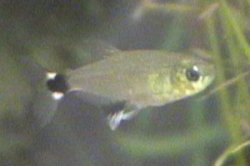 |
 |
|
|
Last Updated: 2/19/14

Quick Information
Description
Setup and Water Preferences
Sexing
Breeding
My Dawn Tetras
Links and Pictures
I am relatively new to keeping dawn tetras (7/8/01) so please feel free to e-mail me with information about them or web site links. For information on my dawn tetras' tank, visit my aquarium page.

Common names: Dawn tetra, Paraguensis tetra, white spot tetra
Scientific/Latin names: Aphyocharax paraguayensis
Maximum length: 1.75 inches
Colors: Natural gray with black and white on the anal and tail fins
Temperature preference: 75 to 82 degrees F
pH preference: 5.5 to 7.5
Hardness preference: Soft
Salinity preference: Low to medium
Compatibility: Varies, usually good, may scare smaller fish
Life span: Unknown
Ease of keeping: Moderate
Ease of breeding: Hard

The Dawn tetra, Aphyocharax paraguayensis, is a pretty tetra with black and white on its anal and caudal fins. They grow to 1.5 to 1.75 inches in length. Their large anal fins has black on it surrounded by a line of white. The base of their caudal (tail) fin is a splotch of black with two white spots on the top and bottom. They are closely related to the bloodfin tetras, although they lack any red on them. The rest of their body is a natural gray color. Dawn tetras are native to South America.

The dawn tetra likes soft, slightly acidic water with a pH from 5.5 to 7.5. Peat filtration is beneficial. Water temperature should be in the range of 75 to 82 degrees F. They like shallow water with lots of plants. Dawn tetras are mostly top-swimming fish. They are very active and stay out in the open. One aquarist (see links below) reports that they may "scare" other small fish (no reports of damage though) into staying in hiding while they dominate the open areas. In my tank, the dawn tetras swim near the top, in the open, and most other fish do hide except for the young honey gouramis who are not intimidated. Of course, my other fish (neon tetras and corydoras habrosus) hid before the dawn tetras were even in the tank anyway. Like most tetras, dawn tetras should be kept in large groups. While they prefer small live foods (various insect larvae like mosquitoes, worms, and brine shrimp are a few choices), they will eat most fish food flakes and other carnivorous foods.

Males are thinner, and females are fatter right before spawning. Males are said to be slightly larger. Males' anal fins may have a larger black region with a wider white border.

To induce breeding, the water level should be reduced and the lighting subdued. Hardness should be low (2-4 KH) with a pH near 6.0. Newborns are smaller than most tetras and require infusuria and other micro-foods for three weeks before being large enough to eat newborn brine shrimp. Eggs and fry are prone to fungal infections. I have yet to read any accounts of any actual spawnings.


I currently have no dawn tetras. I bought four dawn tetras on 7/8/01 and added them to my twenty gallon tank. I chose this species over other tetras (I wanted to try a new species of tetra) because I found them visually appealing, despite the fact that, unlike most tetras, they lack any red, blue, or yellow color. These tetras were sold to me as Paraguensis tetras. I had to look through my Baensch fish atlas to find a photo that matched to find out what they were. They spent most of their time at the surface and movde quickly. During feeding time, they trid to get as much as they could, and their abdomens swelled considerably. They ate whole freeze-dried mosquito larvae which got stuck in their mouths but eventually went in. While chasing each other, they did not seem to do any damage. They ignored the other fish. Around 8/7/01, I could only find three of them. I found the dead dawn tetra on 8/11/01. The others seemed healthy and fast. Another dawn tetra vanished sometime around 8/31/01 and yet another around 9/9/01. I only had one left! I wish I knew what happened. They seemed 100% healthy. When going to get some more fish for the 20 gallon tank, I saw a lone dawn tetra so I bought him/her on 9/16/01 to join the one remaining dawn tetra. The two dawn tetras liked to chase/nip each other but they seemed to like it! As of 4/18/02, I had never seen the dawn tetras try to hurt the other animals in the tank (fish, shrimp, and frogs) but they did chase each other.
By 5/7/02, the two dawn tetras were doing well and never caused problems for the other fish AT ALL. This is contrary to everything I have read on them. They lived with glowlight tetras and African dwarf frogs and never bothered them.
One dawn tetra died on 8/17/02, leaving only one left who is lonely. That fish died on 7/2/03. I only had him/her for two years.

The following links contain information and photos of the dawn tetra. Most of the above information came from these sources and the Baensch fish atlas. Let me know if you know of any other links on them.
Photos of my dawn tetras:
Dawn tetra on 7/14/01.
Dawn tetra on 4/28/02.
|
|
Pet Link Banner Exchange: |

|
|
|
There have been 51,181,002 file views (file views since 2006, page views before that) to Fishpondinfo from December 1, 2003 through August 17, 2019 (stats lost after that). |
|

|

|
E-mail RobynCopyright © 1997-2025 Robyn Rhudy |

|
 |